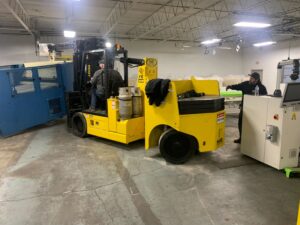In the dynamic landscape of modern industrial and commercial operations, the efficiency of workflow management is pivotal for maintaining a competitive edge. Among the various systems enhancing operational efficiency, conveyor systems play a crucial role in streamlining the movement of materials and products within a facility. With the right installation and careful planning, these systems can significantly boost productivity and minimize operational bottlenecks. This article aims to highlight the key considerations essential for maximizing workflow efficiency during the installation of conveyor systems.
Understanding the Importance of Conveyor Systems in Workflow Efficiency
Conveyor systems serve as the backbone of numerous industries, including manufacturing, distribution, and logistics. By automating the movement of goods, they facilitate seamless transportation, sorting, and distribution, ultimately reducing manual labor and expediting the overall production process. Proper installation of conveyor systems is paramount for achieving optimal workflow efficiency, minimizing downtime, and ensuring the smooth flow of materials.
Pre-Installation Planning and Assessment
Before the installation process begins, a thorough assessment of the facility and a comprehensive evaluation of workflow requirements are imperative. This step involves analyzing the layout, dimensions, and specific needs of the operation. Factors such as the type of materials to be transported, the required speed of conveyance, the weight capacity, and the layout of the production floor all contribute to determining the most suitable conveyor system for the facility.
Selecting the Appropriate Conveyor System
Choosing the right conveyor system is a critical decision that significantly influences the overall workflow efficiency. Different types of conveyor systems, such as belt conveyors, roller conveyors, and chain conveyors, serve distinct purposes and are suitable for varying operational requirements. Evaluating factors like load capacity, speed, material handling, and the specific application of the system is essential in making an informed decision.
Ensuring Compatibility with Existing Infrastructure
During the installation process, it is vital to ensure the compatibility of the new conveyor system with the existing infrastructure. Assessing the electrical and mechanical compatibility of the system with the facility’s power supply and layout is crucial to avoid any operational disruptions or technical complications. Proper integration with the pre-existing machinery, such as packaging equipment or sorting systems, must also be carefully considered.
Customization for Specific Workflow Requirements
To achieve maximum efficiency, customization of the conveyor system based on specific workflow requirements is essential. Tailoring the system to accommodate unique product dimensions, shapes, and weights can prevent potential bottlenecks and enhance the overall productivity of the operation. Adjustable conveyor heights, specialized sorting mechanisms, and integration of automation technologies can be incorporated to optimize the workflow process further.
Safety Measures and Compliance
Prioritizing safety is a non-negotiable aspect of conveyor system installation. Implementing necessary safety features, such as emergency stop buttons, safety guards, and warning signals, is crucial to prevent accidents and ensure the well-being of the workforce. Compliance with industry-specific safety standards and regulations is mandatory, and regular maintenance checks should be scheduled to uphold operational safety and efficiency.
Integration of Automation and Control Systems
In the era of Industry 4.0, the integration of automation and control systems in conveyor installations is becoming increasingly prevalent. Implementing technologies like sensors, programmable logic controllers (PLCs), and automated monitoring systems can optimize the workflow, enable real-time data analysis, and facilitate predictive maintenance, leading to enhanced overall operational efficiency and reduced downtime.
Efficient Maintenance and Regular Inspections
To ensure consistent performance and longevity, regular maintenance and inspections of the conveyor system are imperative. Scheduled assessments of crucial components, such as belts, rollers, motors, and control systems, can preemptively identify potential issues and prevent unexpected downtime. Lubrication of moving parts, calibration of sensors, and timely repairs are vital aspects of a comprehensive maintenance plan.
Employee Training and Operational Knowledge
Equipping the workforce with the necessary training and operational knowledge is essential for the smooth functioning of the conveyor system. Providing comprehensive training on system operation, troubleshooting, and safety protocols empowers employees to handle routine maintenance tasks and effectively address any operational challenges. Additionally, fostering a culture of continuous learning and staying updated with the latest technological advancements is crucial for maximizing the efficiency of the conveyor system.
Monitoring and Performance Evaluation
Continuous monitoring and performance evaluation of the conveyor system are vital for identifying any inefficiencies or operational shortcomings. Implementing key performance indicators (KPIs) and real-time monitoring systems can provide valuable insights into the system’s productivity, identify potential areas for improvement, and enable timely adjustments to enhance overall workflow efficiency.
Conclusion
In the realm of modern industrial and commercial operations, the installation of an efficient conveyor system is paramount for optimizing workflow efficiency and maintaining a competitive edge. By meticulously considering the key factors outlined in this article, including pre-installation planning, system selection, customization, safety measures, integration of automation, efficient maintenance, employee training, and performance monitoring, organizations can ensure the seamless integration of conveyor systems, leading to heightened operational productivity, minimized downtime, and amplified overall efficiency in material handling and transportation. Through strategic implementation and adherence to best practices, organizations can successfully leverage conveyor systems to propel their operations toward greater success and sustained growth in the dynamic landscape of the global market.












